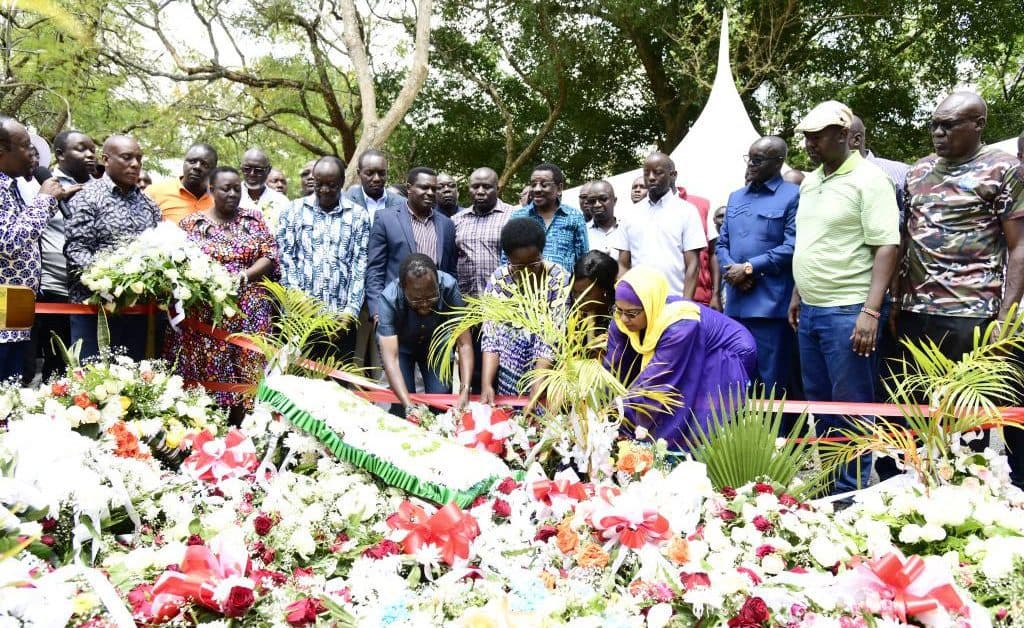We're loading the full news article for you. This includes the article content, images, author information, and related articles.
Weeks after his burial, Raila Odinga's final resting place at Kang'o Ka Jaramogi has transformed into a major pilgrimage site, cementing his enduring influence and creating a new focal point for Kenya's political future.

BONDO, SIaya County – In the quiet village of Kang'o Ka Jaramogi, a steady stream of humanity flows towards a single point of reverence. It is here, at the final resting place of former Prime Minister Raila Amolo Odinga, that a new chapter in his storied legacy is being written, not in political pronouncements, but in the footsteps of thousands of Kenyans who arrive daily. What was once the serene Odinga family homestead has, since his burial on Sunday, October 19, 2025, transformed into a national pilgrimage site, astonishing locals and signaling the potent posthumous influence of a man who dominated Kenyan politics for over three decades.
From dawn until dusk, convoys of buses, private vehicles, and boda bodas navigate the roads leading to the homestead. Visitors from every corner of the nation—including delegations from Mount Kenya, the Rift Valley, and the Coast—converge on the site where Mr. Odinga was laid to rest next to his father, Kenya's first Vice President, Jaramogi Oginga Odinga. The crowds are a cross-section of Kenyan society: governors, senators, church choirs, boda boda riders, and even fans of the Arsenal Football Club, of which Mr. Odinga was an ardent supporter. They come to mourn, pray, and pay homage, turning the gravesite, adorned with fresh flowers and flags, into a living monument.
The influx has profoundly impacted the local economy of Bondo. A micro-economy has sprung up around the Kang'o Ka Jaramogi homestead, which also houses the Jaramogi Oginga Odinga Mausoleum and Museum. Local entrepreneurs are capitalizing on the steady flow of visitors, selling everything from tea and mandazi to portraits of Raila and Orange Democratic Movement (ODM) party memorabilia. “Every day is like a small rally,” George Odhiambo, a local trader, told the Daily Nation. “People come from far—not just Luo Nyanza. We’ve hosted groups from Nakuru, Machakos, and even Nyeri.”
Boda boda operators are experiencing a business boom, ferrying pilgrims to and from the site. This unexpected economic activity provides a tangible measure of the reverence in which Mr. Odinga is held, extending his influence beyond the political sphere into the daily lives of the people in his ancestral home.
For Kenya's political class, the journey to Bondo has become an essential, symbolic act. In the weeks following the funeral, a parade of high-profile leaders has visited the gravesite to condole with the family, led by his widow, Mama Ida Odinga. Notable visitors have included former President Uhuru Kenyatta, who visited just a day after the burial, and numerous governors and MPs from across the political divide. A delegation of Agikuyu elders from Central Kenya, led by Ndia MP George Kariuki, made the journey to express their solidarity, stating, “Raila Odinga was not only your leader; he was also ours in Central Kenya.”
Political analysts observe that these visits are more than mere courtesy calls; they are calculated moves in the country's evolving political landscape. By paying homage at the gravesite, leaders align themselves with Mr. Odinga's formidable legacy, seeking to inherit a piece of his vast political capital. “He still carried the power to anoint the next leader. Being seen to be in Raila's good books even in death is a boon,” political analyst Mark Bichachi told The Eastleigh Voice. The gravesite is fast becoming a new political shrine, a place where allegiances are demonstrated and future ambitions are subtly signaled.
The phenomenon at Kang'o Ka Jaramogi mirrors the historical significance of the resting places of other influential anti-colonial and post-independence African leaders. The homestead, already a national heritage site managed by the National Museums of Kenya, now holds the legacies of both father and son, two central figures in Kenya's struggle for democracy. The Jaramogi mausoleum was officially opened on January 20, 1995, by former Nigerian President Olusegun Obasanjo and has since been a site of historical reflection.
The continuous stream of visitors ensures that Mr. Odinga's contributions to multiparty democracy, constitutional reform, and national unity remain at the forefront of the public consciousness. International recognition has also followed, with Germany's Otto von Guericke University Magdeburg, where he studied engineering, announcing an academic exchange program in his honor. The daily gatherings, prayers, and political delegations at Bondo are a powerful testament that while Raila Odinga the man is gone, his influence on Kenya's soul is more potent than ever.
Keep the conversation in one place—threads here stay linked to the story and in the forums.
Other hot threads
E-sports and Gaming Community in Kenya
Active 6 months ago
Popular Recreational Activities Across Counties
Active 6 months ago
The Role of Technology in Modern Agriculture (AgriTech)
Active 6 months ago
Investing in Youth Sports Development Programs
Active 6 months ago